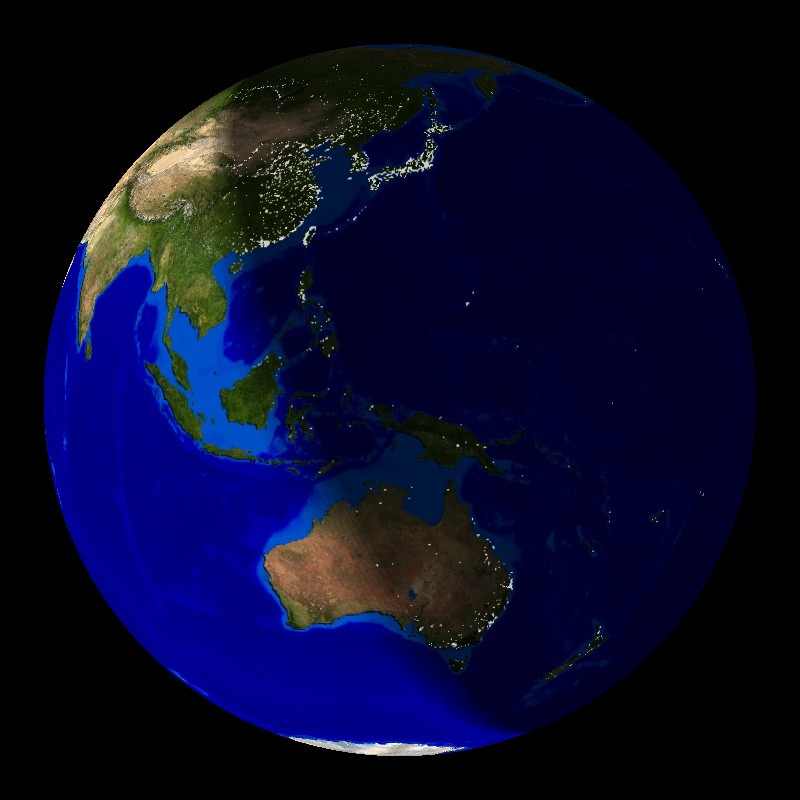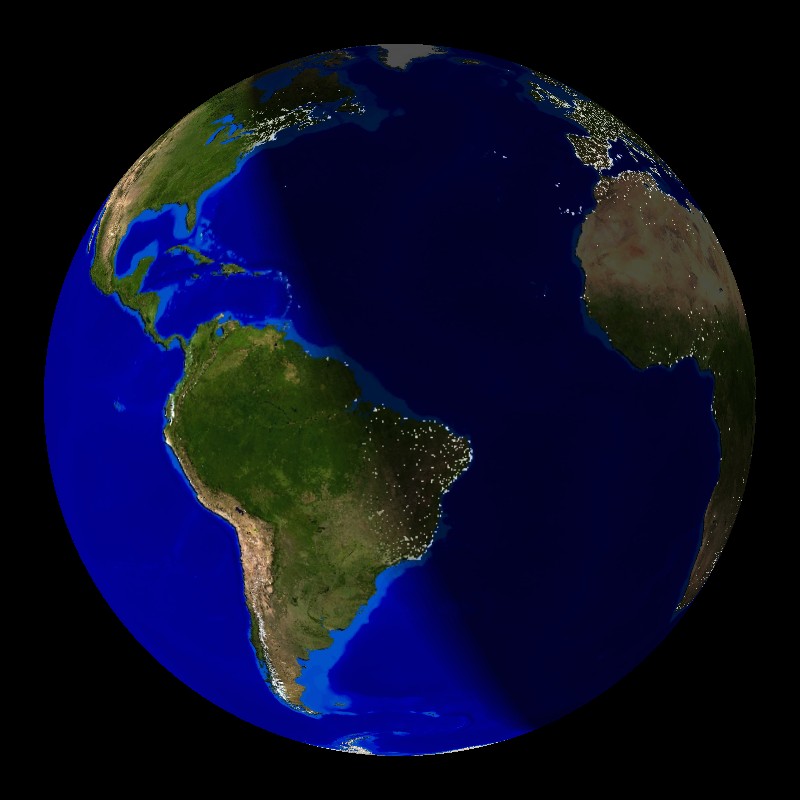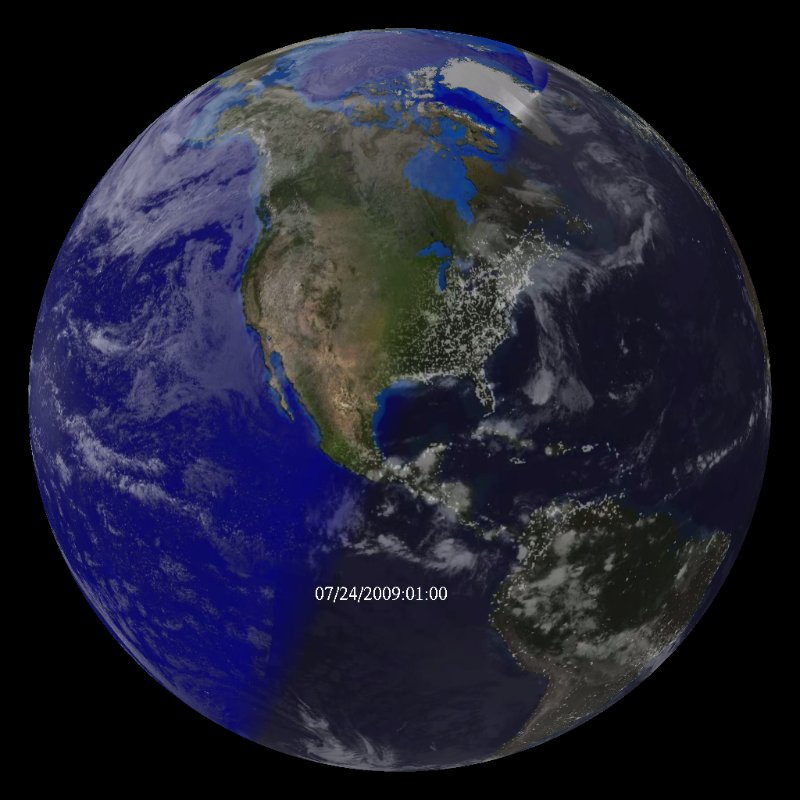Day Night Terminator
Description:
The line that separates day and night is called the terminator. It is also referred to as the "grey line" and the "twilight zone." It is a fuzzy line due to our atmosphere bending sunlight. In fact, the atmosphere bends sunlight by half a degree, which is about 37 miles (60 km). It is commonly thought that while half of the Earth is covered in darkness, the other half is covered in sunlight. This is actually not true because of the bending of the sunlight results in the land covered by sunlight having greater area than the land covered by darkness.
The shape of the terminator curve changes with the seasons. This difference is especially noticeable when the terminator curve from an equinox is compared to the terminator curve from a solstice. There are three different datasets that show the terminator during 2007. In 2007, the spring equinox was March 21, the fall equinox was September 23, the summer solstice was June 21, and the winter solstice was December 22. During the equinox, the sun can be observed directly over the equator. This means that day and night are approximately the same length. The equinox is also thought of as the start of spring and fall. Because at equinox there is no tilt of the Earth with respect to the sun, the terminator line is parallel to the axis of the Earth and to lines of longitude. The solstice occurs when the Earth's axis tilts most toward or away from the sun, causing the sun to be further north or south of the equator than any other time. The shortest day of the year is winter solstice and the longest day is summer solstice. When the Earth is tilted away from the sun, the sun appears south of the equator and when the Earth is titled toward the sun, the sun appears north of the equator. During solstice, the terminator line is at its greatest angle with respect to the axis of the Earth, which is approximately 23.5 degrees.
The first dataset shows the terminator through the entire year. The second dataset has one image for each day,so that the changes in the terminator angle are easy to see. The third dataset is from December 22, 2007, winter solistice and has an image of the terminator postion for every minute of the day. A fourth dataset adds one more element to the animation by including cloud cover as detected by Infrared satellite sensors. This allows viewers to observe the behavior of the clouds through the diurnal cycle. The diurnal cycle is the variation in weather due to the changes from day to night, such as the daily temperature rise and fall. This dataset runs from July 22 - 28, 2009. During July, the diurnal cycle is especially apparent over the central United States, where heating through the day causes thunderstorms to form and strengthen and cooling through the evening weakens the storms.
Notable Features:
- Terminator line parallel to Earth axis at equinox (March 21, Sept. 23)
- Ternminator line at angle of 23.5 degrees during solstice (June 21, Dec. 22)
Data Category
Major: Land
Keywords:
Land, terminator, day, night, equinox, solstice
| Data Set Name | SSEC Day and Night Terminator |
| Data Set Directory Name | day_night/full_year |
| Data Set Source | Rick Kohrs, SSEC, Space, Science and Engineering Center |
| Data Set Developer | Rick Kohrs, SSEC, Space, Science and Engineering Center |
| Visualization Developer | Rick Kohrs, SSEC, Space, Science and Engineering Center |
| Audio | No |
| Contact | Rick Kohrs, SSEC, Space, Science and Engineering Center |
| Download | FTP |
| Data Set Name | Day Night Terminator at 06z through year |
| Data Set Directory Name | day_night/06z_only |
| Data Set Source | Rick Kohrs, SSEC, Space, Science and Engineering Center |
| Data Set Developer | Rick Kohrs, SSEC, Space, Science and Engineering Center |
| Visualization Developer | Rick Kohrs, SSEC, Space, Science and Engineering Center |
| Audio | Yes |
| Contact | Rick Kohrs, SSEC, Space, Science and Engineering Center |
| Download | FTP |
| Data Set Name | One Day Day/Night Terminator |
| Data Set Directory Name | day_night/oneday |
| Data Set Source | Rick Kohrs, SSEC, Space, Science and Engineering Center |
| Data Set Developer | Rick Kohrs, SSEC, Space, Science and Engineering Center |
| Visualization Developer | Rick Kohrs, SSEC, Space, Science and Engineering Center |
| Audio | Yes |
| Contact | Rick Kohrs, SSEC, Space, Science and Engineering Center |
| Download | FTP |
| Data Set Name | Day/Night Terminator with IR sat and Nightlights |
| Data Set Directory Name | irsat_nightlights |
| Data Set Source | Rick Kohrs, SSEC, Space, Science and Engineering Center |
| Data Set Developer | Rick Kohrs, SSEC, Space, Science and Engineering Center |
| Visualization Developer | Rick Kohrs, SSEC, Space, Science and Engineering Center |
| Audio | Yes |
| Contact | Rick Kohrs, SSEC, Space, Science and Engineering Center |
| Download | FTP |


 SSEC Day and Night Terminator (37 mb)
SSEC Day and Night Terminator (37 mb) Day Night Terminator at 06z through year (1 mb)
Day Night Terminator at 06z through year (1 mb) One Day Day/Night Terminator (3 mb)
One Day Day/Night Terminator (3 mb) Day/Night Terminator with IR sat and Nightlights (4 mb)
Day/Night Terminator with IR sat and Nightlights (4 mb)